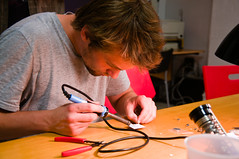 Class Time!
Class Time!
Tonight is the first lab session for our series on learning how to program in study of games with JavaScript. Can’t wait to see everyone here in just a few hours!
Additionally, for anyone who couldn’t make the weeknight-at-7pm time slot, I’ve cleared some time this Sunday to do a repeat/additional session–Sunday, August 12th, at 3pm. You can get tickets here: https://www.wepay.com/events/intro-to-game-programming-with-javascript-weekend-edition
Or hell, just click the button:
Sunday, August 12th, 3pm – 5pm, @ Hive76 Register
Pong!
The first game is, as promised, Pong. You can see the game in action here: http://wedusc.com/games/pong.html
And you can read the source code online in my GitHub repository here: https://github.com/capnmidnight/JS_Game_Programming_Class/blob/master/pong.html
I’ll have printouts for everyone when you get here. If this is your first time trying to read code, try not to cross your eyes too much. We’ll cover how to read code along the way.
Though this game is pretty simple, it has a few interesting features…


 This 5×6 LED tile is a key component in a secret project that I’m developing (in secret) with some other folks (whose names shall remain a secret).
This 5×6 LED tile is a key component in a secret project that I’m developing (in secret) with some other folks (whose names shall remain a secret). You need to flip the tile over in order to see what’s special about it. Here’s a quick list of features that make the assembly what it is:
You need to flip the tile over in order to see what’s special about it. Here’s a quick list of features that make the assembly what it is:
 Modified MendelMax #2 was born today. Isn’t she purty. This bot is gonna live at Hive76 for the forseeable future.
Modified MendelMax #2 was born today. Isn’t she purty. This bot is gonna live at Hive76 for the forseeable future.

